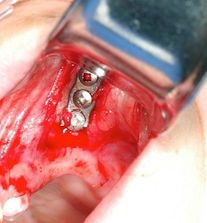 Because the plates are designed to flex, excessive force can cause failure. Because the plates are designed to flex, excessive force can cause failure. BY TUNG T. NGUYEN, DMD, MS In two previous posts (BAMP Part I and BAMP Part II), we have:
The purpose of this post is to share practical information learned from our clinical care of patients. Failures are rarely discussed at meeting or in publications, yet we often learn more from our failures than from our successes. It is these failures that keep us humble and allows us to grow as clinicians. The following article will highlight some of the potential complications encountered in the BAMP treatment and summarize our current philosophy on the use of BAMP. Expect some failures When we started using the BAMP protocol in 2005, our 6-month plate failure rate was 30-35%. The maxillary plates tended to fail more than the mandibular plates, primarily due to bone thickness and quality. With surgical refinements such as the use of pilot holes in the maxilla, the use of the Y-shape plates, localized CBCT to assess infrazygomatic crest bone thickness, and in some cases delaying treatment for a year or more, our plate failure rate has decreased to 10-15%. Our first instinct upon encountering a loose plate is to send the patient back to the surgeon and have it replaced. While experience has shown that replaced plates tend to be more stable due to callus formation at the surgical site, re-operating carries an additional financial cost, as well as psychological anxiety to the patients and doubt from the parents that the procedure might not work. If the plate is loose at 4 weeks post-op, test it by taking a ligature director or scaler and pushing on the plate in a distal direction. Our experience has shown that plates with up to 2mm of mobility have a chance of healing. Load these plates with ¾” 2oz elastics. The light forces will help promote boney remodeling and healing around the surgical site. If the patient cannot tolerate the light elastics, bond a button to the closest tooth and secure the anchor to the button with a ligature tie and recall in 6-8 weeks. This ligature helps to limit the mobility of the loose plate and allows the site to heal. Typically, the mobility of the plate will decrease, and you can start traction force with a ¼” 2oz elastic and progress to stronger elastics at 6-week intervals. Bone plates tend to fail more under the following conditions:
we often have the mindset that if 250g of force is good for orthopedic traction, then 500g is better. After all, reverse pull face masks are often loaded with 500-800g of force. The reality is that heavy forces are often detrimental with BAMP cases. The plates are designed to flex a little to adapt to shape changes that occur with growth of the zygoma and maxilla – and therefore the plates can only resist 400-500 of force. We have seen plate breakage when they are loaded with 500g or more. Orthopedic traction is not correlated most closely to the magnitude of the force, but rather to continuous force application. Based on our experience, we can obtain effective orthopedic maxillary protraction with only 250g of force connecting two bone plates (i.e. 250g of force per side).  Class III growth is unpredictable. Maintaining plates for retention until third molar removal improves stability. Class III growth is unpredictable. Maintaining plates for retention until third molar removal improves stability. Retain until cessation of growth When we started the BAMP protocol in 2005, we would remove the plates after 1 year of treatment or when adequate positive overjet was obtained. The rational for removal at this time was that bone would occasionally grow over the head of the screws making removal difficult. However, we neglected an important concept. Class III mandibular prognathic patients tend to have mandibular growth into late adolescence.1 Our current treatment protocol is to overcorrect to 3-4mm overjet. Patients are instructed to wear 250g elastics (2 x ¼” 4oz on each side) elastics at night and are recalled at 6-month intervals. If the overjet is decreasing, patients are instructed to wear elastics full time. In the rare instances that overjet increases, patients are instructed to only wear elastics every other night or decrease the force level to 125g (¼” 4oz). The plates are then removed at 18 year of age in conjunction with 3rd molar extractions to minimize the amount of surgery. Applications of BAMP Craniofacial cleft patients often have a Class III skeletal malocclusion. Recent studies have shown that BAMP is effective for protracting the maxilla and restraining mandibular growth in these patients.2-3 While effective maxillary protraction decreases after the age of the 14, our long-term study shows BAMP is still effective at restraining mandibular growth into late adolescence. One of our recent applications is using BAMP in older patients (>14 years of age) to reduce the severity of the surgical movement or reduce the need for 2-jaw surgery. Our Treatment Philosophy for Class III patients When Class III malocclusion is detected early, Reverse Pull Headgear (RPHG) has been shown to be effective at reducing the need for orthognathic surgery.4 After 10 years of age, the effects of RPHG are primarily dentoalveolar with a higher relapse rate.5 From age 11-14, BAMP has been shown to be effective at protracting the maxilla and restraining mandibular growth.6-7 After 15 years of age, orthognathic surgery is the treatment of choice, especially if the severity of the malocclusion is large. BAMP can be used to reduce the serverity of the malocclusion and reduce the amount of surgical movement. To Summarize:
1 Comment
|
Curated by:
Tate H. Jackson, DDS, MS CategoriesArchives
October 2019
|
Copyright © 2016
 RSS Feed
RSS Feed